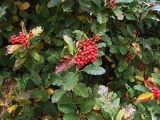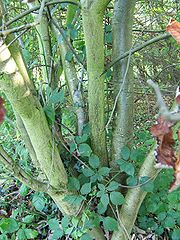
Sorbus mougeotii
Encyclopedia
Sorbus mougeotii is a species of whitebeam
native to the mountains of central and western Europe
from the Pyrenees
east through the Alps
to Austria
, and north to the Vosges Mountains
.
 It is a deciduous
It is a deciduous
shrub
or small tree
growing to 8–10 m (rarely 20 m) tall, often multi-stemmed, with trunks up to 30 cm (rarely 50 cm) diameter and grey bark
; the crown is dense, broad ovoid, with numerous erect branches. The leaves
are glossy dark green above, and densely hairy with white hairs beneath, 6–10 cm long and 3–5 cm broad, broadest near the middle, shallowly lobed with seven to twelve forward-pointing lobes on each side of the leaf, bluntly pointed at the apex, and serrated margins. The autumn colour is dull grey-brown. The flower
s are 10 mm diameter, with five white petals and 20 yellowish-white stamens; they are produced in corymbs 5–10 cm diameter in late spring. The fruit
is a globose pome
10–12 mm diameter, bright red, maturing in mid autumn. The fruit is dryish, and eaten by thrushes
and waxwings
, which disperse the seed
s.
Its closest relatives are some of the endemic British
whitebeams, notably Sorbus anglica
, which differs only in slightly broader leaves. It is also closely related to Sorbus intermedia
(Swedish Whitebeam), which differs in having the leaves grey-white below and more deeply lobed, with the lobes spreading rather than forward-pointing, the fruit oval and less bright red, and in forming a stouter tree with a single trunk and more horizontal branching. All are tetraploid apomictic
species which breed true without pollination, and ultimately of hybrid origin between Sorbus aria
and Sorbus aucuparia
.
name 'Latifolia' (additionally leading to confusion with Sorbus latifolia). It is valued for its tolerance of urban conditions and difficult soil, and is very commonly planted in land reclamation
schemes on slag heap
s and roadside shrub planting. It has also proved very tolerant of oceanic climate
s with cold summers, growing much better than S. intermedia in coastal conditions north to the Faroe Islands
.
Whitebeam
The whitebeams are members of the Rosaceae family, comprising subgenus Aria of genus Sorbus, and hybrids involving species of this subgenus and members of subgenera Sorbus, Torminaria and Chamaemespilus. They are deciduous trees with simple or lobed leaves, arranged alternately...
native to the mountains of central and western Europe
Europe
Europe is, by convention, one of the world's seven continents. Comprising the westernmost peninsula of Eurasia, Europe is generally 'divided' from Asia to its east by the watershed divides of the Ural and Caucasus Mountains, the Ural River, the Caspian and Black Seas, and the waterways connecting...
from the Pyrenees
Pyrenees
The Pyrenees is a range of mountains in southwest Europe that forms a natural border between France and Spain...
east through the Alps
Alps
The Alps is one of the great mountain range systems of Europe, stretching from Austria and Slovenia in the east through Italy, Switzerland, Liechtenstein and Germany to France in the west....
to Austria
Austria
Austria , officially the Republic of Austria , is a landlocked country of roughly 8.4 million people in Central Europe. It is bordered by the Czech Republic and Germany to the north, Slovakia and Hungary to the east, Slovenia and Italy to the south, and Switzerland and Liechtenstein to the...
, and north to the Vosges Mountains
Vosges mountains
For the department of France of the same name, see Vosges.The Vosges are a range of low mountains in eastern France, near its border with Germany. They extend along the west side of the Rhine valley in a northnortheast direction, mainly from Belfort to Saverne...
.

Deciduous
Deciduous means "falling off at maturity" or "tending to fall off", and is typically used in reference to trees or shrubs that lose their leaves seasonally, and to the shedding of other plant structures such as petals after flowering or fruit when ripe...
shrub
Shrub
A shrub or bush is distinguished from a tree by its multiple stems and shorter height, usually under 5–6 m tall. A large number of plants may become either shrubs or trees, depending on the growing conditions they experience...
or small tree
Tree
A tree is a perennial woody plant. It is most often defined as a woody plant that has many secondary branches supported clear of the ground on a single main stem or trunk with clear apical dominance. A minimum height specification at maturity is cited by some authors, varying from 3 m to...
growing to 8–10 m (rarely 20 m) tall, often multi-stemmed, with trunks up to 30 cm (rarely 50 cm) diameter and grey bark
Bark
Bark is the outermost layers of stems and roots of woody plants. Plants with bark include trees, woody vines and shrubs. Bark refers to all the tissues outside of the vascular cambium and is a nontechnical term. It overlays the wood and consists of the inner bark and the outer bark. The inner...
; the crown is dense, broad ovoid, with numerous erect branches. The leaves
Leaf
A leaf is an organ of a vascular plant, as defined in botanical terms, and in particular in plant morphology. Foliage is a mass noun that refers to leaves as a feature of plants....
are glossy dark green above, and densely hairy with white hairs beneath, 6–10 cm long and 3–5 cm broad, broadest near the middle, shallowly lobed with seven to twelve forward-pointing lobes on each side of the leaf, bluntly pointed at the apex, and serrated margins. The autumn colour is dull grey-brown. The flower
Flower
A flower, sometimes known as a bloom or blossom, is the reproductive structure found in flowering plants . The biological function of a flower is to effect reproduction, usually by providing a mechanism for the union of sperm with eggs...
s are 10 mm diameter, with five white petals and 20 yellowish-white stamens; they are produced in corymbs 5–10 cm diameter in late spring. The fruit
Fruit
In broad terms, a fruit is a structure of a plant that contains its seeds.The term has different meanings dependent on context. In non-technical usage, such as food preparation, fruit normally means the fleshy seed-associated structures of certain plants that are sweet and edible in the raw state,...
is a globose pome
Pome
In botany, a pome is a type of fruit produced by flowering plants in the subfamily Maloideae of the family Rosaceae.A pome is an accessory fruit composed of one or more carpels surrounded by accessory tissue...
10–12 mm diameter, bright red, maturing in mid autumn. The fruit is dryish, and eaten by thrushes
Thrush (bird)
The thrushes, family Turdidae, are a group of passerine birds that occur worldwide.-Characteristics:Thrushes are plump, soft-plumaged, small to medium-sized birds, inhabiting wooded areas, and often feed on the ground or eat small fruit. The smallest thrush may be the Forest Rock-thrush, at and...
and waxwings
Bohemian Waxwing
The Bohemian Waxwing is a member of the waxwing family of passerines. A sleek bird, 18–21 cm long with a pointed crest, it travels in large, nomadic groups with a strong, direct flight. It breeds in coniferous forests throughout the most northern parts of Europe, Asia and western North America...
, which disperse the seed
Seed
A seed is a small embryonic plant enclosed in a covering called the seed coat, usually with some stored food. It is the product of the ripened ovule of gymnosperm and angiosperm plants which occurs after fertilization and some growth within the mother plant...
s.
Its closest relatives are some of the endemic British
Great Britain
Great Britain or Britain is an island situated to the northwest of Continental Europe. It is the ninth largest island in the world, and the largest European island, as well as the largest of the British Isles...
whitebeams, notably Sorbus anglica
Sorbus anglica
Sorbus anglica, the English whitebeam is a species of tree in the Rosaceae family. It is uncommonly found in Ireland and the United Kingdom, with an entire British population estimated at about 600. individuals.-Source:...
, which differs only in slightly broader leaves. It is also closely related to Sorbus intermedia
Sorbus intermedia
Sorbus intermedia is a species of whitebeam in southern Sweden, with scattered occurrences in easternmost Denmark , the far southwest of Finland), the Baltic States, and northern Poland....
(Swedish Whitebeam), which differs in having the leaves grey-white below and more deeply lobed, with the lobes spreading rather than forward-pointing, the fruit oval and less bright red, and in forming a stouter tree with a single trunk and more horizontal branching. All are tetraploid apomictic
Apomixis
In botany, apomixis was defined by Winkler as replacement of the normal sexual reproduction by asexual reproduction, without fertilization. This definition notably does not mention meiosis...
species which breed true without pollination, and ultimately of hybrid origin between Sorbus aria
Sorbus aria
Sorbus aria , the Whitebeam or Common Whitebeam is a deciduous tree, compact and domed, with few upswept branches; it generally favours dry limestone and chalk soils. The hermaphrodite cream-white flowers appear in May, are insect pollinated, and go on to produce scarlet berries, which are often...
and Sorbus aucuparia
Sorbus aucuparia
Sorbus aucuparia , is a species of the genus Sorbus, native to most of Europe except for the far south, and northern Asia...
.
Cultivation and uses
It is widely grown as an ornamental tree in northern Europe, though usually unrecognised, misidentified as Sorbus intermedia. Although described in 1858, it was only brought into widespread cultivation in the 1950s by the Danish Heath Society, being sold as a "new improved form" of Sorbus intermedia, sometimes with the cultivarCultivar
A cultivar'Cultivar has two meanings as explained under Formal definition. When used in reference to a taxon, the word does not apply to an individual plant but to all those plants sharing the unique characteristics that define the cultivar. is a plant or group of plants selected for desirable...
name 'Latifolia' (additionally leading to confusion with Sorbus latifolia). It is valued for its tolerance of urban conditions and difficult soil, and is very commonly planted in land reclamation
Land reclamation
Land reclamation, usually known as reclamation, is the process to create new land from sea or riverbeds. The land reclaimed is known as reclamation ground or landfill.- Habitation :...
schemes on slag heap
Slag heap
A spoil tip is a pile built of accumulated spoil - the overburden removed during coal and ore mining. These waste materials are generally composed of shale, as well as smaller quantities of carboniferous sandstone and various other residues...
s and roadside shrub planting. It has also proved very tolerant of oceanic climate
Oceanic climate
An oceanic climate, also called marine west coast climate, maritime climate, Cascadian climate and British climate for Köppen climate classification Cfb and subtropical highland for Köppen Cfb or Cwb, is a type of climate typically found along the west coasts at the middle latitudes of some of the...
s with cold summers, growing much better than S. intermedia in coastal conditions north to the Faroe Islands
Faroe Islands
The Faroe Islands are an island group situated between the Norwegian Sea and the North Atlantic Ocean, approximately halfway between Scotland and Iceland. The Faroe Islands are a self-governing territory within the Kingdom of Denmark, along with Denmark proper and Greenland...
.

